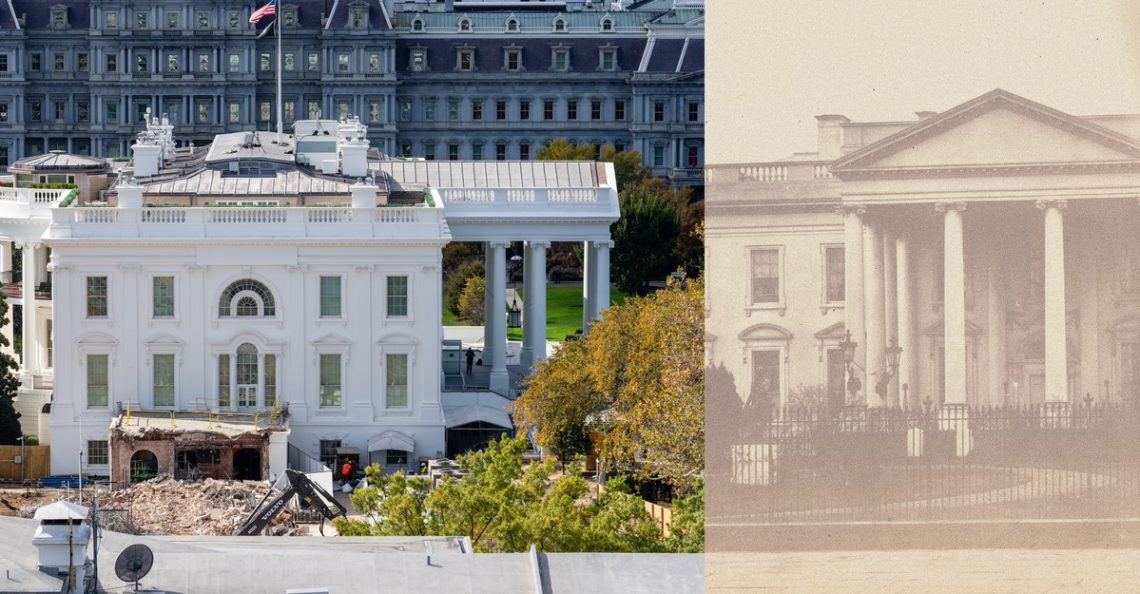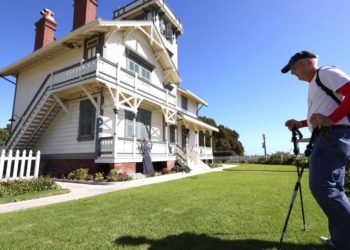Late on August 24, 1814, a troop of about 150 British sailors and marines arrived at the White House. They did not come as honored guests, though they would treat themselves as such. James and Dolley Madison, the official residents, had fled earlier amid preparations for an event in the formal dining room. The table was already set, the food prepared, and the British helped themselves to a sumptuous feast, toasting the future King George IV and commenting on the fine Madeira. When they were done, the men moved to the Madisons’ private rooms. A bit scruffy from the campaign to reach Washington, one exchanged his dirty shirt for a fresh one from James’s wardrobe. The admiral in charge took a cushion from a chair of Dolley’s to carry with him as a reminder of her “seat.” When they were done, they torched the curtains, beds, and piled effects. The White House burned into the night. In the morning, a heavy rain fell on the charred shell of the original structure.
This week’s demolition of the East Wing of the White House was not undertaken by a hostile foreign power, but it did come to many people as more of a surprise than the 1814 burning did. (The British, at least, had warned that they were coming.) Most learned of the East Wing’s fate via the stunning images of heavy machinery reducing it to rubble, followed by off-the-cuff confirmations from within the administration. The first proposed plan of a ballroom meant to stand near the existing structure had been scrapped, and with it, so was the East Wing.
The White House, as the administration’s defenders of the project are keen to point out, has never been fixed in time. It has changed and grown with the presidents who have lived there— a living organism changing along with the nature of the presidency and the meaning of the republic. But summarily smashing part of it without telling people threatens the fundamental idea of the republic—government by the people and for the people, conducted in public view. The British burned the Capitol before going to the White House. Now Congress is closed for business, ceding much of its power to the executive it was meant to contain.
That ongoing conversation about what a republic should look like began with the capital city itself. In the years just after the ratification of the Constitution, a French engineer and Continental Army veteran named Pierre Charles L’Enfant brought with him the architectural grandeur and monarchical sensibilities of his home continent. His plan for the new federal city that would become Washington was breathtaking in scale: broad avenues radiating from monumental squares, a landscape designed to “give an idea of the greatness of the empire” and to “engrave in every mind that sense of respect that is due to a place which is the seat of a supreme sovereignty.” Although L’Enfant’s design is lost, we know that the “presidential palace” he imagined was five times the size of what became the White House.
Not everyone approved. Thomas Jefferson, himself an amateur architect and a student of classical form, saw danger in such magnificence. In an essay from the 1780s on architecture, he had warned against what he called “barbarous ornaments”; he preferred the construction of “sufficiently chaste” buildings. The new nation, he believed, should build not like a monarchy but like a republic: modestly and rationally.
The executive residence that was eventually built, and that Jefferson would occupy, reflected that compromise. The Irish-born architect James Hoban designed the basic structure: the stately but restrained residence modeled in part on an 18th-century Georgian townhouse in Dublin. The sensibilities of the place implied permanence but also fit within the broader classical ideals that Jefferson had emphasized: order, proportion, and discipline. These were the conditions in which virtue—the animating quality of republican government—would thrive.
As the White House (it would be called that informally after its sandstone surface was whitewashed in 1798, and then officially after 1901) evolved, debates over its proper form continued to unfold. Alterations great and small seemed to tilt the balance back and forth between grandeur and restraint. Even Jefferson, who took the concept of republican simplicity to extremes, often entertaining in ratty slippers and a robe, was attacked when he added colonnades to connect the main house with its service buildings. His opponents, the same Federalists who had favored the courtly, elaborate style of the Washington and Adams administrations, accused him of betraying his own principles.
In 1840, Representative Charles Ogle mocked Martin Van Buren’s alleged introduction of “spoons of gold” and gilded touches, which, he said, turned household decor and furnishings into a parable of decadence and excess. Theodore Roosevelt’s 1902 renovation reversed the trend, stripping away the Victorian ornament that had crept in. Almost half a century later, when structural decay forced Harry Truman to rebuild the White House from the inside out, the work was done with scrupulous deference to what the building represented. Working closely with Congress, Truman oversaw a publicly accountable restoration while offering citizens the chance to purchase individual bricks from the demolition for $1.
The demolition of the East Wing steps outside the long-standing framework that has governed changes to the building. In balancing the ideas of grandeur and restraint, the White House has been the site of a running conversation about what the presidency should say to the people it serves. Donald Trump’s project is proceeding without public notice, and the new ballroom—nearly double the size of the main residence, and running to $300 million, by Trump’s newest estimation—is being paid for not by Congress but by “many generous Patriots, Great American Companies, and, yours truly,” as Trump put it. In its scale and placement, the addition leaves the site unbalanced: a structure now thrown off center, its sense of proportion lost. Draped in oversize classical garb, it borrows the forms of tradition but not its discipline.
Just before she left the White House in August 1814, Dolley Madison ordered Gilbert Stuart’s portrait of George Washington to be removed from its frame and taken from the house. When she returned after the war, she helped rally sentiment for keeping the capital in Washington, her presence lending continuity to the broken city.
More than a century later, long after Dolley Madison left for good and the East Wing was built under Franklin D. Roosevelt, that side of the house became the seat of the first ladies. It became the center of social and ceremonial life, an essential counterpart to the political and administrative workings of the West Wing. During Trump’s first term, the East Wing stood largely dormant. With it gone, Trump commented that “it was never thought of as being much,” revealing less about the building than about his indifference to its history.
The president’s administration has said that the renovations will make it easier to host state dinners and large events. In the ballroom that will rise where the rubble now sits, tables will be set and sumptuous feasts will be offered. But who, and what, will be toasted there?
The post Trump’s White House Demolition Threatens the American Idea appeared first on The Atlantic.




